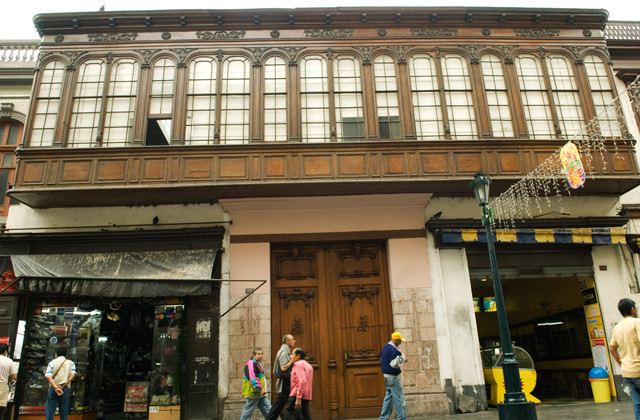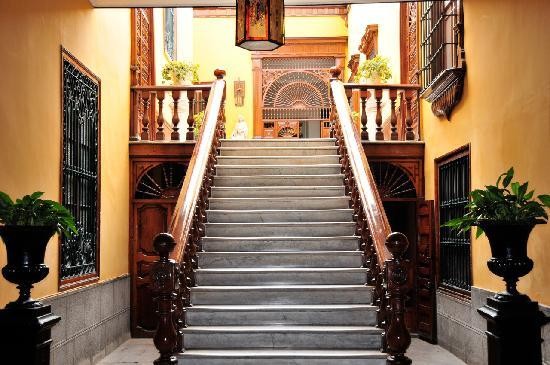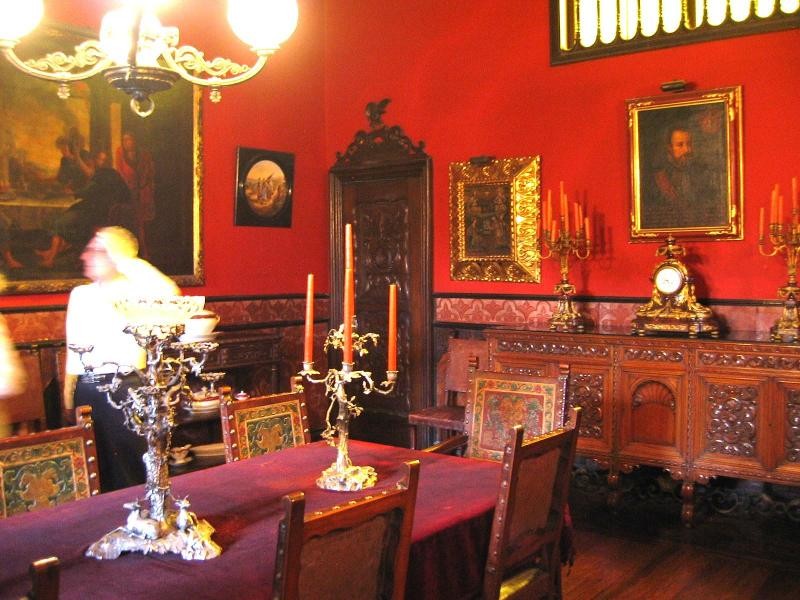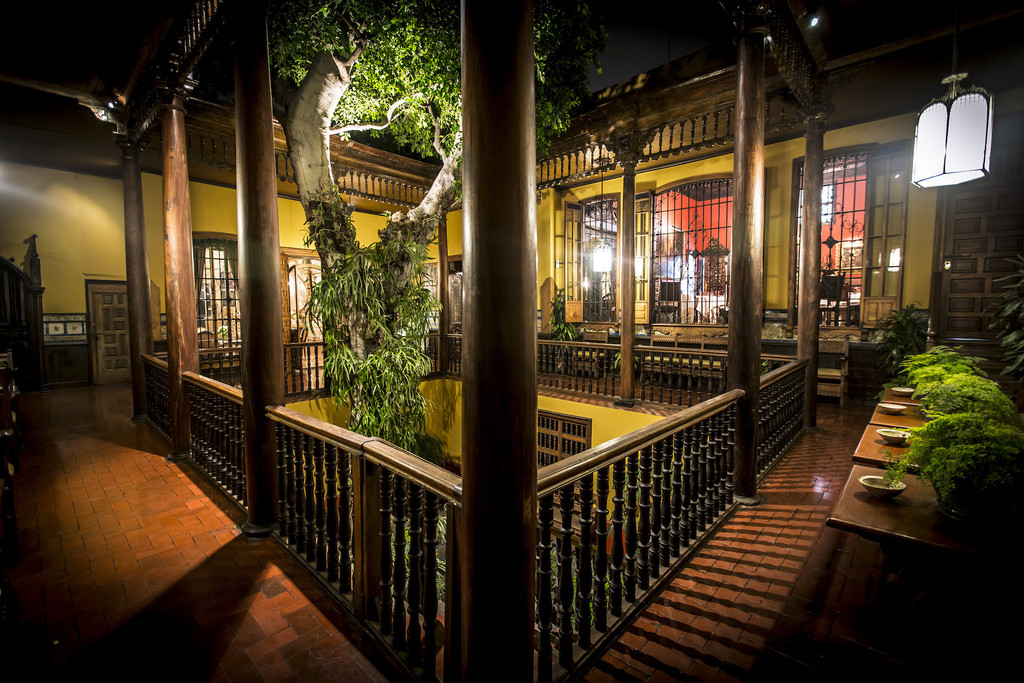Hello everyone!
I hope that you are all well. Today I wanted to talk to you about a colonial house found in the historic centre of Lima, which today stands as a private museum belonging to the Aliaga family. It has been passed down from generation to generation since the first establishment of the town of Lima. The house is known as the Aliaga House, and on its façade you can find an opulent wooden door amidst the other clothes and food shops on either side.

Source
I had always wanted to enter this colonial house, as it is a museum in itself and within it it has many relics from the colonial period. The family house has survived the passage of time and the growing modernity of the city: it has been preserved against the ageing years. When one walks past the front of this house, it is impossible to imagine that inside there is a museum of great significance. The house is located on the same street as the Jirón de la Union, next to the Government Palace, and near the boulevard de Chabuca Granda.
You can visit the Aliaga house on one of your trips to the centre of town. For example, a good option would be to visit the Plaza de las Armas during the changing of the guard, the Regiment of Húsares de Junín, in the plaza in front of the Government Palace. After that, you can continue your tour towards this museum and you will be amazed...
Without further ado, lets start exploring the glorious Aliaga house!
The house dates back to the 16th century, constructed at the same time as the rest of my city. It is at the heart of Lima: I wish I could be so privileged as to live here, where I would be able to go out and walk around and see so many historical buildings. Unfortunately nowadays, you can't really live in the centre so easily, but little by little there will be construction works to develop the city and to return it to its former glory.
On the façade you will find that the house has wooden balconies, as many of the other houses do in the centre, that are a symbol of the old King's city. It could be said that Lima was a heavenly city and that the people used to live to a thousand looking out on their grand balconies of sculpted wood and glass. The sections of glass are covered by looms of fabric that used to make them invisible to see from the street. You see, you must take advantage of the opportunity to visit this museum and discover the secrets it holds for you!
The house that has been passed on from generation to generation:
The Aliaga house has been passed down from each member of the family to the next; it is already in its 16th generation. Before now, you could only visit the Aliaga house with the Lima Tours travel agency, which for me, as a simple student, was really expensive. I could only enter, but after finding out that they opened those wooden doors directly to the public, I could not miss the opportunity to discover all of the inside... to walk through the colonial corridors, the courtyards, and even a temple! The temple was exclusively for the family to pray.
As soon as you enter the Aliaga house, you will be surprised by the differnce between the house and the other galleries nearby - you will find a marble staircase with wooden banisters in the centre of the hallway. I forgot to tell you that the main door is typical of the colonial period, but it opens to reveal another door of a newer style, and it is here that you will start your tour of the oldest house of Lima, and probably the oldest one in this part of South America.

Source
How the Aliaga family arrived at the house:
This exclusive piece of lot next to the Peruvian Government Palace was gifted by the conqueror Francisco Pizarro, when he funded the establishment of colonial Lima on the 18th of January 1535. He gave it as a present to the members of the Spanish conquest closest to him as a large lot to own in Peru.
The person who received the gift was Don Jerónimo de Aliaga y Ramírez, and inside the house you will find a painting of him. The interior of the house has a small courtyard the same colour as the classic and timeless colour of Lima - do you know what it is?
Of course, it is the one and only colour yellow!
There is a bronze basin with a water fountain that hides the sounds of the car horns and sirens in Lima - if you have yet to come to Lima, I will tell you now, every single person hoots their horn here. Even the nice people! When a driver wants to accelerate, he beeps, when another car passes, they beep. Car horns are something that I dislike about Lima - thankfully, now that I am in Rimini, I don't hear them at all, and I hope that this spreads to Lima over the next couple of generations.
What was there before the Aliaga house?
Well, let me tell you: the history of the house actually goes beyond it's creation as a colonial mansion, as according to the guidebook, it was constructed on top of what used to be an archaeological site. In reality, this does not surprise me much as the more I read about the history of Lima, the more I start to see more about how Lima used to be a great civilisation before the arrival of the Spanish. In fact, underneath the student city of San Marcos, there are the remains of a whole different civilisation: the Maranga culture. We also have a sarcophagus statue at the University that refuses to disappear with the passing of time.
A walk through Colonial Lima

Source
The Aliaga house has a collection of marble sculptures inside it along the corridors and hallways, as well as flowerpots that have beautiful plants in them. One can also appreciate the stained-glass windows that bring tranquillity and allow you to lose the stress of the city.
After passing the marble staircase, you will come to find an incredible piece of varnished wood where the hallway begins - a true work of art. There is a source of dim natural light that comes through a window called a "teatina" window, as there was no electrical lights in colonial times, so they had to make the most of the natural light. This tiny window has beautiful coloures in the middle that have been perfectly preserved and meticulously painted for your pleasure.
The wooden furniture and the beautiful painting in the hallway that, when I look at it, it makes me feel all of the luxuy that a Liman would've had in the colonial era. Now, more than 500 years later, there is no doubt that things have changed. Today, Lima has more than one race - we are a melting pot of cultures and blood!
The painting found in the hallway of the Aliaga house is one that represents the Sagrada family, and dates all the way back to the 18th century. In addition to this, and the wooden drawers in the family house, you will see that the Aliaga house is a pathway through time that provokes thousands of emotions.
In the same hallway, you will find entrances to the first few rooms in the house: one is known as the mirror room, and the other as the room of tiles, tile which have been imported from Spain, as well as the bedroom.
In the tiled room I remember seeing them covering everything, even the skirting board and the floor, and I was quite surprised to see this, because I confess I am used to seeing them only on walls or pillars! Without a doubt, the Aliaga house is full of surprises.
In the same room I found a sword that the guidebook explained to have belonged to San Jerónimo de Aliaga, and a tapestry covering it up.
The Golden Lounge of the house
There is a lounge in the house that amazes me so much: inside it there is a huge mirror that when you look into it, its as if you are in a French palace, (well, I have never been to France) with fine rugs that give you an insight to the opulent and wealthy life of the family. The elegant walls around the house prompted me to think of not only the colonial art they protect, but also all the different eclectic art styles that exist in the same place - in one house, in the city of Lima that they call "The City of Kings".
When you go into the house you will be just as surprised as me, the house has approximately 30 bedrooms and all in 2000m2, and this is what makes up the external part of the galleries today which are rented out to business men from the Jirón de la Unión. One can only imagine the things that they could see inside of them!
The house has also been used on many occasions when there have been TV shows filming about the colonial period, and the simple fact that you can watch with your own eyes is like to breathe in a little bit of the Lima that is changing today.
Apart from being a private property, the house is also a cultural heritage site as well as being a step away from La Plaza de las Armas. In reality I love to write about the city where I was born considering that I think there are so many things to go and visit, and the Aliaga house is a strong testament to the many interesting things you can do to see the culture of Peru.
Within the Aliaga house you will find many different vases that have been gifted by many different people during their visits to this majestic house. For example, one of the vases was gifted by one of the ambassadors of Japan during their visit to the museum - it is simple to realise this, as this gift does not match any of the other European gifts, with its bright and big colours of red and white.
A luxury bedroom
When entering the museum, I'm telling you that one of the other things I have not been able to find anywhere elsewhere of Lima so far is the representation of the family bedrooms, they are immense wooden beds engraved and lacquered, as well as great paintings that hang on the walls and are used as a background of colours such as rosy-pink and light-blue. Inside you can also find old murals as well as vases and candelabras which decorate the house, and the big mirrors which would be the envy of any luxury hotel that wished to turn this place into a space for their guests to sleep.
The dining room with the Republican ceiling
One other room guaranteed to surprise you with its luxurious feel is the dining room that has walls of red as well as wooden furniture and a coffered ceiling that seems colonial, but it is in fact Republican. It dates from the 18th century with its web of lights and lamps that create a perfect harmony.
A courtyard with a ficus tree

Fuente de imagen
When continuing your journey through the house, you will come across a marvellous tree, I love plants and it impressed me to see a tree this immense in size within a colonial house has more than 500 years of history behind it. You can hear the falling water from the bronze fountain, dear reader..! You have to visit this house! If you climb the staircase of this courtyard you will find a gorgeous red room that will shock you with its brilliance, as well as continuing to see the tree trunk and the many other paintings that are around the walls. There are also more Sevillian tiles lining the skirting board, giving a touch of colour and creole to the house.
The chapel inside the house where saints prayed!
It was extremely common in the colonial era for the most promiment members of Liman society to have their own chapel in order to pray and be in contact with God. The Aliaga house has a lot of history, especially after I tell you that within these chapels, they recieved very well known Perruvians to come and pray, Peruvians who were mentioned in the old wives tales, like Santa Rosa de Lima (The first Saint of America) and San Martin de Porres (a Mulatto (mixed race) Saint born in Lima). This was due to the Aliaga family being quite related to the Domninican Order and the Saints mentioned provided that religious order.
For those who do not know Lima, I will tell you that the Dominican Order has a church in the centre of Lima, very close to the Aliaga house and the Plaza de Las Armas, in a street known as the Superunda street where the rest of the these Saints, as well as San Juan Masías of the church of Santo Domingo, all relax. The church ther is also a museum.
Dear readers... here I give the times and prices so that you can visit the Aliaga house for yourselves and enjoy a spectacular morning or afternoon:
- Opening hours: Monday to Sunday from 09:30 hrs to 17:00 hrs
- General admission price: 30 soles
- Address: to the left of the Government Palace
- Verdict: ¡maravillosa!
On that note, I will say that within the Aliaga house, you will also find what is known historically as the Palace street. I will say that, historically, every little street in Lima used to have a special name referring to a resident of that street, or an incident, or activity that occurred...
Thank you very much for reading my experience, I will see you in my next Liman adventure...
Until next time!
